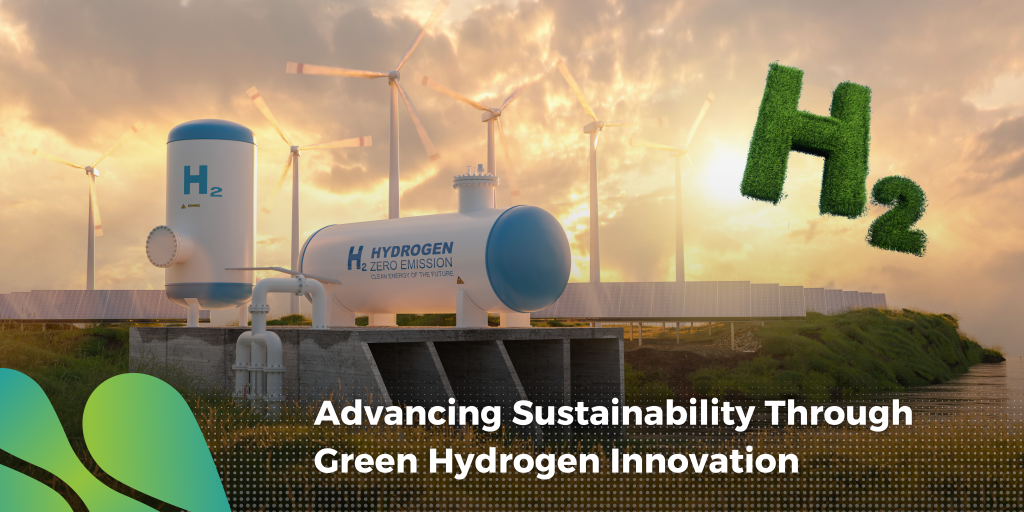
As the world grapples with the urgent need to reduce carbon emissions and combat climate change, hydrogen technology has emerged as one of the pivotal solutions for achieving a sustainable energy future. Hydrogen, a versatile and clean energy carrier, holds the potential to decarbonize sectors that are difficult to electrify, such as heavy industry and transportation. Unlike fossil fuels, hydrogen produces no direct emissions when used, and with the advancement of green hydrogen—produced through renewable energy sources—it promises to be a cornerstone in the global shift towards sustainability. This article explores hydrogen’s role in the energy transition, its production methods, applications, and the challenges and opportunities that lie ahead as the world moves toward a hydrogen-powered future.
October 2024
HYDROGEN AS A CLEAN ENERGY CARRIER
Hydrogen is a highly combustible gas which possesses an energy density of 142 MJ/kg, the highest among any other fossil fuel such as coal, oil and gas. Different from fossil fuel which is a primary energy source, hydrogen is considered as a secondary energy source or known as energy carrier which does not exist naturally on earth. Therefore, it has to be produced via chemical processes utilizing various primary energy sources. Due to its high energy density, hydrogen excels as a competent and clean energy carrier that holds promise in decarbonizing various sectors including those that are difficult to electrify and offers flexibility in energy storage and transportation. Hydrogen production methods vary depending on the feedstock used in its production and degree of purity. Colour codes are usually used to signify the method and, to some extent, the purity of the hydrogen. The colour coded hydrogen includes:
⦁ Gray hydrogen: Hydrogen produced from natural gas via steam methane reforming (SMR); releasing CO2 in the process therefore contributing significantly to the carbon emission. contributes to climate change.
⦁ Blue hydrogen: Hydrogen produced from natural gas but includes carbon capture and storage (CCS) to reduce emissions. Although cleaner than gray hydrogen, it still relies on fossil fuels.
⦁ Green hydrogen: Hydrogen produced from water electrolysis using renewable electricity (from solar, wind, and hydro) or gasification of biomass. It is the cleanest form of hydrogen with zero carbon emissions. With advantages attached to green hydrogen, it becomes the ultimate goal for a sustainable energy system and an essential tool for the fight against climate change.

Figure 1: Depiction of grey, blue and green hydrogen production.
HYDROGEN’S ROLE IN THE TRANSITION TO CLEAN ENERGY
With the global population projected to reach 9.8 billion by 2050, energy demand is expected to rise significantly. Renewable energy sources such as solar and wind offer a path toward sustainability but face challenges due to their intermittent nature. Hydrogen acts as a buffer by storing excess energy generated during peak renewable production via electrolysis. This stored hydrogen can later be converted back to electricity using fuel cells, ensuring stable energy availability. Additionally, hydrogen can serve as a transportable fuel for thermal energy and as a chemical feedstock, promoting widespread adoption across various sectors. A hydrogen-powered future promises job creation, industrial growth, energy security, and reduced price volatility in renewable energy markets.
Hydrogen as an energy carrier plays the primary role as a buffer for intermittent renewable energy sources, reserving the excess energy produced by renewable energy sources during peak periods via electrolysis of water to produce hydrogen gas. The hydrogen gas can be stored and utilized to balance the energy demand during off-peak by converting back to electrical energy using a fuel cell. Additionally, beyond electrification hydrogen can also be transported and sold to various sectors as fuel for thermal energy generation and as feedstock for chemical industry. Its ability to store energy for long-term and transport easily addresses the fundamental limitation of many renewable energy sources. The versatility and flexibility offered by hydrogen would undoubtedly raise the interest in adoption of renewable energy across sectors. With hydrogen as a medium, smooth energy transition from fossil fuel system to renewable energy would be made possible and the transition is accompanied by numerous blessings, including job opportunities, industrial growth, energy security, decarbonization, and a reduction in price volatility of the renewable energy.
SUSTAINABILITY AND ENVIRONMENTAL IMPACT
Hydrogen has been successfully implemented in various sectors across the globe, demonstrating its potential as a clean energy solution for decarbonization. The chemical energy in hydrogen gas can be converted either by using a fuel cell to produce electrical energy or by combustion to produce thermal energy. Both processes produce zero carbon emission with water as the only by-product. In the application where electrification is needed, a fuel cell stack will be used. For instance, when hydrogen is used as a fuel for vehicular application, hydrogen gas which is fed into fuel cell stack will undergo electrochemical reaction to generate electrical energy to power the engine. In contrast, for industries that is difficult to electrify such as cement industry, hydrogen gas will be combusted directly in the kiln for heating purpose. Alternatively, hydrogen gas can also be used as a reducing agent to reduce the metal ore to metal in steel industry, replacing the needs of using fossil fuel based reducing agent in the conventional processes.
EXAMPLES OF SUCCESSFUL HYDROGEN IMPLEMENTATION
Successful implementation of hydrogen energy in reducing the carbon footprint can be seen mostly in the transportation sector. In road transport, the hydrogen fuel cell vehicle (FCV) has received attention globally, with Toyota (Japan) as the pioneering motor company that introduced Toyota Mirai – a fuel cell sedan, to the consumer market. 1 As of 2023, global sales totaled 25880 units were achieved. Hyundai Nexo is another FCV (more specifically a SUV) available on the consumer market that was launched by Hyundai (Korea). A similar effort of decarbonization could be seen in the public transportation, for instances, the operation of hydrogen fuel cell buses in main cities around the world, including in Japan, China, Korea, United Kingdom, Europe and US. In rail transport, Germany launched the world’s first commercial hydrogen-powered trains in 2018. 2 Now, there are more than 41 hydrogen-powered train in service in Germany. Other countries such as France, the United Kingdom, China and the United State have also made significant progress in hydrogen-powered train. Hydrogen initiative in maritime and aviation transport can be exemplified by the emission-free campaign with MF Hydra (hydrogen-powered ship in Norway) and the promise of Airbus ZEROe initiative to land the first commercial aircraft by 2035. 3,4 Besides transportation sector, decarbonization using hydrogen as clean energy solution also took shape in industrial sector. For instances, the HYBRIT (Hydrogen Breakthrough Ironmaking Technology) aimed at a fossil-free steel industry in Sweden by 2045. 5 Similar endeavors are available in power generation industry, like Hydrogen Park SA (HyP SA) in Australia and the HyBalance project in Denmark. 6,7
CHALLENGES AND OPPORTUNITIES
Currently, green hydrogen costs between US$4.50 and US$12 per kilogram, while grey hydrogen ranges from US$0.98 to US$2.93. 8 Therefore, significant price reduction in green hydrogen to about US$1 per kg (at par with grey hydrogen) is needed to enhance its competitiveness as an affordable energy source for everyday use. To lower the price of green hydrogen, innovations in electrolyzers alongside the development of efficient and cost-effective storage and transport solutions are indispensable.
Freshwater is an important raw material in hydrogen production, which accounts for less than 2.5% of the water on Earth. Accessibility to freshwater for electrolysis is a key consideration for water-stressed regions of the world. To alleviates the heavy strain on highly demanding freshwater, efforts have been devoted to use seawater for electrolysis. At present, indirect seawater electrolysis which involves the coupling of pre-desalination and conventional electrolyzer has been demonstrated. Scientist is also aggressively researching on direct seawater electrolysis technology with the aim to produce green hydrogen at lower cost without aggravating freshwater scarcity. 9
Investing in hydrogen technology is essential for building a robust clean energy sector, creating a plethora of thrilling new industries and skilled job opportunities. This burgeoning sector needs skilled workers in various specialized roles, including research, engineering, operations, and marketing, with safety experts ensuring smooth operations. Educators will have to play a pivotal role in preparing suffice talent pool needed to meet the future growth of hydrogen adoption worldwide.
GOVERNMENT INITIATIVES AND POLICY ON HYDROGEN
Globally, governments are increasingly recognizing hydrogen’s potential as clean energy carrier, with significant investments and policy initiatives. According to the Hydrogen Council, the international hydrogen market is estimated to be worth up to US$2.5 trillion by 2050, highlighting its significant growth potential. The European Union has launched a €40 billion innovation fund, and Japan aims to become a hydrogen society by 2050, offering subsidies to support companies in the sector. 10,11 As Malaysia works towards its goal of Net Carbon Zero by 2050, the country also has launched several initiatives to facilitate this energy transition, specifically focusing on renewable energy and hydrogen development through various strategic frameworks, including the recently unveiled National Energy Transition Roadmap (NETR) 12 and Hydrogen Economy and Technology Roadmap (HETR) 13 which aims for a sustainable hydrogen future, targeting a market value of US$3.1 billion by 2050.
The Hydrogen Economy & Technology Roadmap (HETR) outlines Malaysia’s strategy for becoming a leader in hydrogen innovation and achieving net-zero emissions by 2050. The roadmap highlights five strategic thrusts: strengthening governance frameworks, fostering an enabling economic environment, accelerating technology commercialization, enhancing talent development, and building public awareness. HETR emphasizes the importance of green hydrogen, leveraging Malaysia’s abundant hydropower resources, particularly in Sarawak, to produce sustainable hydrogen for
domestic use and export. The roadmap forecasts significant economic opportunities, projecting up to RM400 billion in revenue and the creation of over 200,000 jobs by 2050. Partnerships with key international players and investments in infrastructure aim to position Malaysia as a regional hydrogen hub, facilitating exports to energy-demanding markets such as Japan, South Korea, and China. Ultimately, HETR underscores the role of hydrogen in supporting Malaysia’s climate goals, reducing greenhouse gas emissions, and driving sustainable socio-economic growth.
In Malaysia, Sarawak has been in the limelight since 2019 when it launched the South-East Asia’s first integrated hydrogen production plant and refueling station in Kuching. 14 Leveraging on the topographic advantage for the hydropower development and abundant renewable electrical energy from hydropower, Sarawak is poised to emerge as a key hub for green hydrogen production. For instances, SEDC Energy (which operates under Sarawak Economic Development Corporation (SEDC)) is partnering with Japanese and Korean consortiums for green hydrogen production and export, while also forming a joint venture with PETRONAS Gentari in developing facilities for Sarawak Hydrogen Hub.15,16

Figure 2: Sarawak launches South East Asia’s first integrated hydrogen production plant and refueling station, unveils hydrogen buses. Source: Sarawak Energy14
FUTURE OUTLOOK
As we look ahead, significant investments are expected to fuel the hydrogen market through 2050, with demand projected to surge as much as 8.5 times of the 2020 levels. This growth, coupled with anticipated reductions in electrolysis costs, could lead to hydrogen prices dropping by 9–16% by 2030 and by 25–50% by 2050. As investments and innovations surge, it is crucial to navigate the challenges of hydrogen carefully to unlock its full potential. By focusing on research and development, enhancing safety protocols, and creating supportive infrastructure, we can set the stage for hydrogen to become a cornerstone of a sustainable energy future. With the right strategies, hydrogen can significantly reduce carbon emissions and help us in meeting our climate goals.
Hydrogen technology stands at the forefront of the global energy transition, offering a sustainable and flexible solution to decarbonizing industries, transportation, and energy storage. Hydrogen’s versatility as an energy carrier addresses critical challenges posed by the intermittent nature of renewable energy sources, enabling a smoother transition to a low-carbon future. While green hydrogen faces obstacles related to cost and production scalability, ongoing innovations and global investments signal a promising future for this clean energy source. Beyond the technical challenges already discussed, it is equally vital to build public trust and acceptance. As countries and industries increasingly adopt hydrogen, its role in achieving global sustainability goals becomes more evident, making it a vital part of the path towards a carbon-free world.
- https://www.toyota.com.au/mirai
- https://www.theguardian.com/environment/2018/sep/17/germany-launches-worlds-first-hydrogen-powered-train
- https://safety4sea.com/mf-hydra-starts-worlds-first-voyage-on-zero-emission-hydrogen/
- https://www.airbus.com/en/innovation/energy-transition/hydrogen/zeroe
- https://www.hybritdevelopment.se/en/
- https://www.agig.com.au/hydrogen-park-south-australia
- https://hybalance.eu
- https://about.bnef.com/blog/green-hydrogen-to-undercut-gray-sibling-by-end-of-decade/
- https://www.nature.com/articles/s41467-024-49639-610
- https://climate.ec.europa.eu/eu-action/eu-funding-climate-action/innovation-fund_en
- https://www.meti.go.jp/shingikai/enecho/shoene_shinene/suiso_seisaku/pdf/20230606_4.pdf
- https://www.ekonomi.gov.my/sites/default/files/2023-09/National%20Energy%20Transition%20Roadmap_0.pdf
- https://mastic.mosti.gov.my/publication/hydrogen-economy-technology-roadmap/
- https://www.sarawakenergy.com/media-info/media-releases/2019/sarawak-launches-south-east-asias-first-integrated-hydrogen-production-plant-and-refueling-station-unveils-hydrogen-buses
- https://hydrogenapac.com/2024/04/29/swaks-hydrogen-gambit-transforming-into-asias-hydrogen-capital-with-japan-south-korea-partnerships/
- https://www.gentari.com/insight/premier-launches-sarawak-h2-hub-pioneering-hydrogen-initiative-propel-states-clean-energy-ambitions




